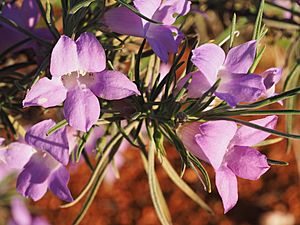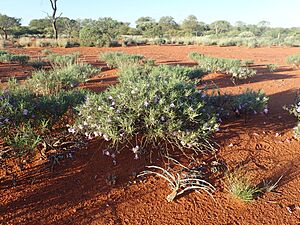Eremophila foliosissima facts for kids
Quick facts for kids Eremophila foliosissima |
|
|---|---|
 |
|
| E. foliosissima foliage and flowers | |
| Scientific classification | |
| Genus: |
Eremophila (plant)
|
| Species: |
foliosissima
|
The Eremophila foliosissima, often called poverty bush, is a fascinating flowering plant. It belongs to the figwort family, also known as Scrophulariaceae. This plant grows only in Western Australia, meaning it is endemic to that area. It's a small, upright shrub with many leaves packed closely together. The leaves are long, narrow, and covered in tiny hairs. Its flowers are a beautiful mauve (light purple) to purple color. The poverty bush looks similar to another plant, Eremophila gilesii, but it's usually denser and more rounded. It also has more crowded leaves and different types of hairs on its flowers.
Contents
What it Looks Like
The Eremophila foliosissima is an upright, rounded shrub. It's usually less than 0.5 m (2 ft) (about 1.6 feet) tall. Its stems and leaves are covered with short, stiff, white hairs. Older leaves often hang down, forming a thick mat around the stem.
The leaves are packed tightly along the stems. They are long and thin, about 40–88 mm (2–3 in) (1.5 to 3.5 inches) long. Each leaf is only 1–2 mm (0.04–0.08 in) (less than an inch) wide. Young leaves are often shiny and a bit sticky.
Flowers and Fruits
The flowers usually grow one by one where a leaf meets the stem. Each flower sits on a hairy stalk that is 4–13 mm (0.2–0.5 in) long. There are 5 sepals, which are small leaf-like parts that protect the flower bud. These sepals are hairy and about 5–13.5 mm (0.2–0.5 in) long.
The petals are joined together at the bottom to form a tube. The whole flower tube is usually 20–40 mm (0.8–2 in) (about 0.8 to 1.6 inches) long. The outside of the petal tube and its tips are light purple or lilac. The inside of the tube is white. The outside of the flower is covered with tiny glandular hairs, which can feel a bit sticky. The inside of the tips is smooth, but the inside of the tube is filled with long, soft hairs.
This plant has 4 stamens, which are the parts that produce pollen. These stamens are completely hidden inside the petal tube. The poverty bush flowers from July to September. After flowering, it produces fruits that are oval or almost round. These fruits are 8–12 mm (0.3–0.5 in) (about 0.3 to 0.5 inches) wide and have a pale yellow, papery covering.

Plant Classification and Name
The Eremophila foliosissima was first officially described in 1925. This description was made by a scientist named Friedrich Wilhelm Ludwig Kraenzlin. He published his findings in a science journal called Bulletin of Miscellaneous Information.
The second part of its scientific name, foliosissima, comes from a Latin word. It means "leafiest," which makes sense because this shrub has so many leaves!
Where it Grows
This type of eremophila plant is found across a wide area in Western Australia. You can find it between the Shire of Murchison and Warburton. It grows in different types of soil, including sand, clay, or loam. It often grows in mulga woodlands, which are forests mainly made up of mulga trees.
Conservation Status
The Western Australian Government's Department of Parks and Wildlife has looked at the Eremophila foliosissima. They have classified it as "not threatened." This means the plant is not currently in danger of disappearing.
Growing Poverty Bush in Gardens
The poverty bush is a great plant for gardens. It has long, narrow, grayish, slightly hairy leaves and large blue to purple flowers. These features make it a very attractive plant that stands out.
It can be a bit tricky to grow new plants from seeds. It's also hard to grow them from cuttings (small pieces of the plant). The most reliable way to grow new poverty bushes is by grafting them. This means joining a piece of the poverty bush onto another plant, often a Myoporum species. The best time to do this is from late summer to early autumn.
Grafted poverty bushes can grow in almost any soil. All poverty bushes like full sun or partial shade. They are also very good at handling long periods without rain (droughts). However, they can be damaged by very cold frosts. If you live in a humid (moist) area, like Sydney, it's best to plant them where there is good air movement.

